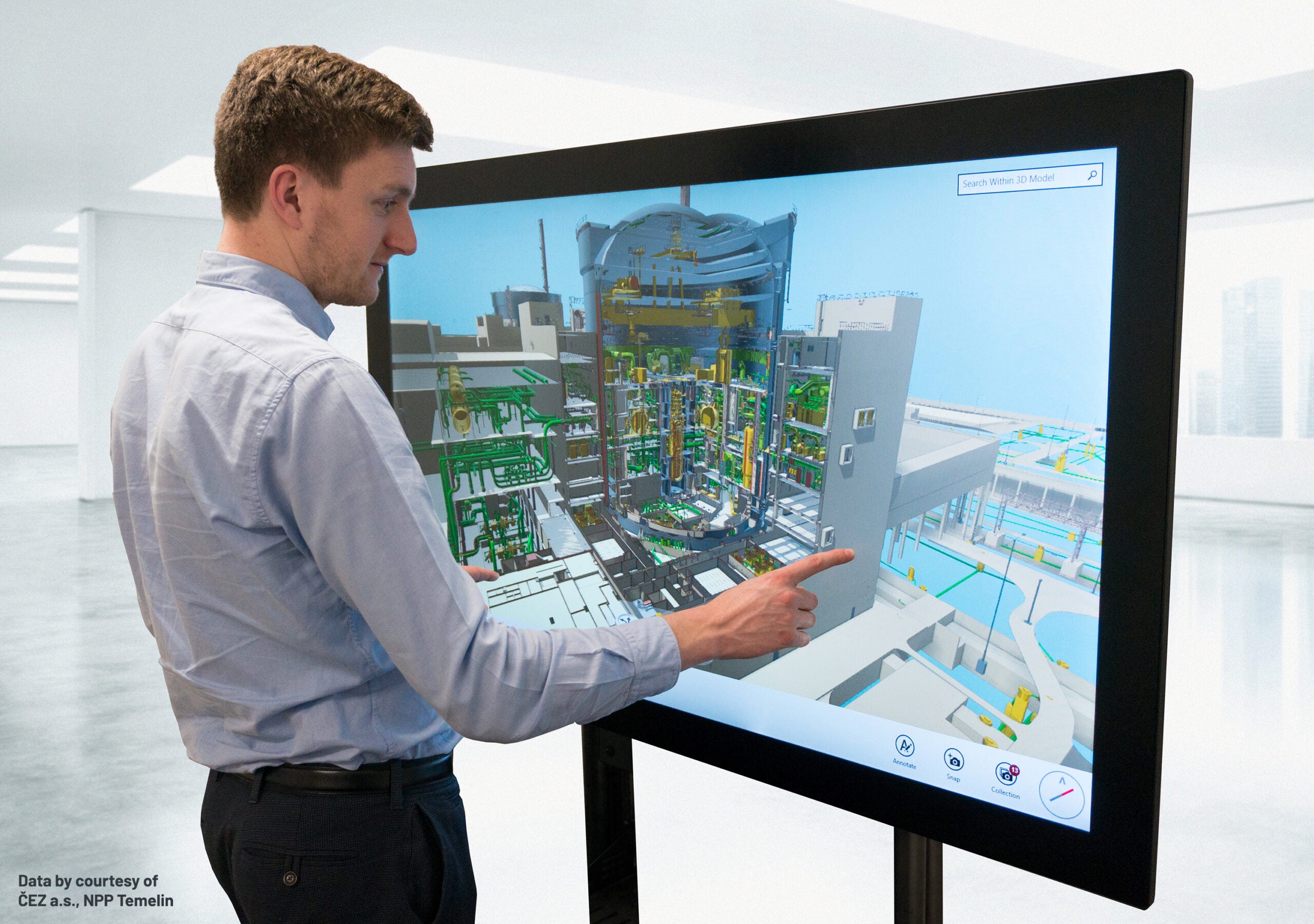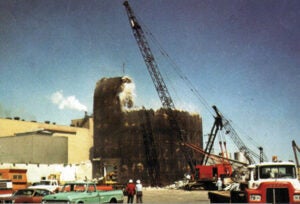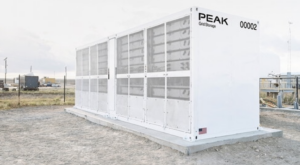
AVEVA enables nuclear operators to achieve measurable outcomes through integrated digital ecosystems
August 2025
Executive summary
As nuclear operators face increasing demands for agility, safety, and cost control, the industry is under pressure to modernize how data is used across the asset lifecycle. Real-time operational intelligence is no longer a luxury—it’s the backbone of grid flexibility. With global nuclear spending forecast to rise from $38.84 billion in 2024 to almost $44.71 billion by 2029, success will depend on operators’ ability to unify engineering, operations, and asset data into seamless digital environments that deliver measurable business outcomes. [1] The growing demand for reliable, clean electricity generation is driving this investment as nuclear power plays an increasingly critical role in global energy security. [2]

Bruce Power: A blueprint for nuclear digital transformation
Bruce Power, the world’s largest operating nuclear facility with eight reactor units and 6,555 megawatts of installed capacity, exemplifies how strategic digital transformation can deliver measurable operational improvements across nuclear fleets. The Ontario-based facility leveraged AVEVA’s integrated platform to digitize operations across its entire fleet, creating a unified digital ecosystem that has fundamentally transformed how the organization manages information, executes projects, and operates its facilities.
Read More About AVEVA Success Story – Bruce Power: Powering digital transformation with data-centric processes Customer Case Study
The challenge: Information fragmentation across complex operations
Before embarking on digital transformation, Bruce Power faced a challenge that plagues many nuclear operators: critical information scattered across multiple disconnected systems. With 720,000 equipment codes, 4,000 operational flowsheets, 1.7 million documents, and 40,000 real-time plant information tags spread across five enterprise systems, employees spent significant time searching for information rather than making decisions.[3]
The complexity of nuclear operations demands seamless access to accurate, up-to-date information. When engineering teams need to resolve design conflicts, optimize maintenance schedules, or conduct safety assessments, delays in accessing the right data can cascade into significant cost and schedule impacts. Early resolution of design conflicts delivers measurable savings in downstream labor and materials, making information accessibility a critical business driver.
Bruce Power’s challenge extended beyond simple data access. Its operational teams needed to coordinate activities across multiple engineering disciplines, manage complex regulatory requirements, and maintain the highest safety standards while optimizing performance. Traditional approaches to information management, with data siloed in separate systems, created barriers to the cross-functional collaboration essential for nuclear operations.
The transformation: Unified digital ecosystem implementation
Bruce Power’s approach centered on creating a unified digital ecosystem that could integrate disparate data sources while maintaining the security, reliability, and regulatory compliance requirements essential for nuclear operations. Rather than implementing isolated point solutions, the facility selected an integrated platform approach that could provide the scale and ecosystem necessary to meet comprehensive nuclear facility requirements.
As Patrick Desbiens, Program Manager of Digital Engineering at Bruce Power, explains: “It was important for us to partner with someone who had that scale and ecosystem to meet all our needs, and that’s where we selected AVEVA”.[3] This strategic decision enabled Bruce Power to consolidate data from multiple systems into unified digital representations, creating a single source of truth for all facility information.
The implementation required careful coordination across multiple operational areas. Bruce Power’s team worked to integrate legacy systems with modern digital capabilities, ensuring that transformation enhanced rather than disrupted proven operational procedures. The platform’s ability to preserve existing workflows while enhancing them with digital capabilities proved essential for maintaining operational continuity.
Measurable outcomes: Quantifying digital transformation value
Bruce Power’s digital transformation has delivered concrete, measurable results that demonstrate the business value of unified digital platforms in nuclear operations.[3]
- Remote operations capability: By connecting eight reactor units and 15 major projects into a unified digital ecosystem, Bruce Power enabled remote operations that allow field teams to remotely complete tasks that once required physical travel to hazardous, radiological areas. This improves worker safety by reducing radiation exposure while increasing operational efficiency and enabling more flexible workforce deployment.
- Engineering acceleration: The automation of engineering processes has helped Bruce Power achieve 50% cost and schedule savings at engineering closeout. This dramatic improvement reflects the compound benefits of eliminating information search time, reducing design conflicts, and streamlining project workflows. For nuclear projects where schedule delays can cost millions of dollars per day, these improvements represent substantial value creation.
- Data integration at scale: Within six months of deployment, Bruce Power laser scanned seven of its eight reactor units and uploaded 15 additional projects, totaling approximately 8.5 terabytes of integrated data. This wealth of point-cloud data, previously accessible only to select personnel, now enables operations teams to conduct safety pre-job briefs and supports comprehensive facility management.
- User adoption and productivity: The platform now supports over 1,800 unique users who have collectively saved more than 1,000 hours of search time. Bruce Power’s digitized flowsheets serve as key entry points into their unified system, demonstrating how intuitive interfaces can drive organization-wide adoption of digital tools.
Operational excellence through data integration
The transformation extends beyond simple information management to enable new operational capabilities that were previously impossible with fragmented systems. Bruce Power’s unified digital environment allows engineering teams to access the right data at the right time without navigating multiple disconnected systems, enabling timely decision-making that directly impacts operational performance.
This integration creates a foundation for advanced analytics and predictive maintenance strategies that can further optimize plant performance. When operational data flows seamlessly between systems, operators can identify patterns, predict equipment behavior, and optimize maintenance schedules in ways that are impossible with isolated data sources.
AVEVA: The nuclear industry’s digital transformation expert
AVEVA’s integrated industrial intelligence platform addresses the fundamental challenges facing nuclear operators through a comprehensive approach that unifies engineering, operations, and asset data across the entire nuclear lifecycle. The platform’s strength lies in its ability to manage the complex, multi-disciplinary workflows that characterize nuclear operations while maintaining the security, reliability, and regulatory compliance standards that define the industry.
Platform integration across the nuclear lifecycle
The nuclear industry’s unique requirements demand digital solutions that can operate reliably for decades while adapting to evolving operational needs. AVEVA’s products address these requirements through several key capabilities proven in nuclear environments worldwide.
- Unified engineering environment: AVEVA™ Unified Engineering demonstrates particular strength in managing the complex, multi-disciplinary workflows that characterize nuclear projects. The platform’s ability to coordinate activities across multiple engineering disciplines and organizational boundaries directly addresses coordination challenges that have historically plagued nuclear projects. When design teams, operations personnel, and maintenance staff can access the same information simultaneously, the result is faster decision-making, reduced conflicts, and improved project outcomes.
- Asset information management: AVEVA™ Asset Information Management consolidates equipment data, documentation, and operational procedures into centrally accessible repositories that eliminate information silos. This capability becomes increasingly important as nuclear facilities operate for 60, 80, or even 100 years, requiring digital systems that can preserve and enhance institutional knowledge across multiple generations of operators.
- Operational data foundation: AVEVA™ PI System™ provides the operational data foundation that enables condition-based maintenance strategies across nuclear fleets. The platform’s ability to handle millions of time-series data points from diverse sensor types creates the information backbone necessary for predictive analytics and advanced operational strategies. AVEVA PI System’s proven reliability in mission-critical environments makes it particularly well-suited for nuclear operations where data integrity and system availability are paramount.
Addressing nuclear’s unique requirements
Nuclear operations present unique challenges that require specialized digital platform capabilities. Safety systems, regulatory compliance, cybersecurity requirements, and operational complexity all demand digital solutions that go beyond standard industrial automation platforms.
- Security and compliance: The platform incorporates the security frameworks and compliance capabilities necessary for nuclear operations, ensuring that digital transformation enhances rather than compromises operational security. This includes support for air-gapped networks, role-based access controls, and audit trails that meet nuclear regulatory requirements.
- Scalability and reliability: Nuclear facilities require digital platforms that can operate reliably for decades while scaling to accommodate evolving operational requirements. AVEVA’s platform architecture supports this long-term perspective through modular design, proven reliability, and the ability to integrate with both legacy and modern systems.
- Integration flexibility: The platform’s ability to integrate with existing nuclear systems ensures that digital transformation can proceed without disrupting proven operational procedures or safety systems. The platform can work with existing historian systems, maintenance management platforms, and engineering tools, creating a bridge between legacy investments and modern capabilities.
Economic impact and strategic value
The business case for unified digital platforms in nuclear operations extends beyond operational efficiency to encompass significant financial returns across both capital and operational phases of nuclear projects.[4] Digital integration delivers measurable value during nuclear construction and major modification projects, where unified engineering and digital handover routinely reduce direct project costs by 8-15% and schedules by 10-20%.
Over extended plant lifecycles, well-executed digital transformation programs achieve substantial returns on investment. Operational benefits include maintenance optimization through predictive strategies that deliver measurable reductions in maintenance costs while improving equipment reliability. Enhanced operational visibility and decision-making capabilities can improve capacity factors, representing millions in annual revenue for large nuclear facilities.
The economic benefits scale significantly when implemented across nuclear fleets, creating network effects where the value of digital transformation multiplies as more facilities are connected to integrated systems. This scalability becomes increasingly important as nuclear power addresses emerging market demands, including the growing electricity needs of data centers and digital infrastructure. [5] Fleet-scale implementation enables standardization benefits, cross-plant learning, and optimized resource allocation across multiple facilities simultaneously.
According to Richard Rys P.E., Director of Consulting at ARC Advisory Group, “over 50 companies are actively developing Small Modular Reactors (SMRs) and advanced reactors to address the increasing demand for clean electric power. These new reactors incorporate digital technology across their design, control, operation, monitoring, and maintenance, enhancing safety, efficiency, and flexibility. Unlike previous reactor designs, the new reactors may feature improved load following, integration with hydrogen production, molten salt thermal energy storage, and the capability to provide process heat for industrial applications. AVEVA is particularly well-suited to offer digital platforms that meet the integration needs of this new generation of highly integrated nuclear reactors.”
Conclusion: The path forward for nuclear digital excellence
The nuclear sector is entering a new era where digital transformation defines operational resilience, regulatory agility, and competitive strength. Bruce Power’s success demonstrates that with the right partner, transformation delivers measurable return on investment, not just incremental gains.[3] The facility’s achievement of 50% cost and schedule savings, remote operations capability across eight reactor units, and actionable insights from over 8.5 terabytes of integrated data proves that comprehensive digital transformation is both achievable and valuable in nuclear operations.
AVEVA’s integrated industrial intelligence platform unifies engineering, operations, and asset data to drive performance across the entire nuclear lifecycle. The platform’s proven ability to manage complex, multi-disciplinary workflows while maintaining the security and reliability standards essential for nuclear operations makes it the ideal foundation for nuclear digital transformation initiatives.
In a market demanding flexibility, cost control, and sustainability, nuclear operators need more than technology—they need proven partners who understand the complexity of nuclear operations and can deliver real-time, data-driven results at scale.
The nuclear industry’s digital transformation requires strategic partnerships that combine deep operational understanding with proven technological capabilities. As the sector navigates increasing complexity and evolving market demands, the organizations that successfully integrate unified data platforms will be positioned to lead in operational excellence, safety performance, and long-term competitiveness.
References
[1] Globe Newswire. “Nuclear Power Industry Research 2024-2029.” January 6, 2025. https://www.globenewswire.com/news-release/2025/01/06/3004771/28124/en/Nuclear-Power-Industry-Research-2024-2029-Modernization-of-Energy-Infrastructure-Opens-Opportunities.html
[2] International Energy Agency. “Electricity 2024.” January 2024. https://www.iea.org/reports/electricity-2024
[3] AVEVA. “Bruce Power: Powering digital transformation with data-centric processes.” 2025. https://discover.aveva.com/infuse-media-smr/successstory-bruce-power-powering-digital-transformation-with-data-centric-processes
[4] McKinsey & Company. “Global Energy Perspective 2045.” April 2024. https://www.mckinsey.com/industries/energy-and-materials/our-insights/global-energy-perspective
[5] Deloitte Research Center for Energy & Industrials. “Nuclear energy’s role in powering data center growth.” April 9, 2025. https://www.deloitte.com/us/en/insights/industry/power-and-utilities/nuclear-energy-powering-data-centers.html









